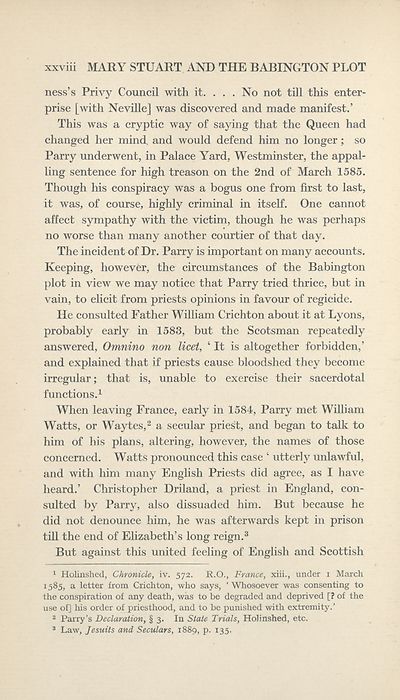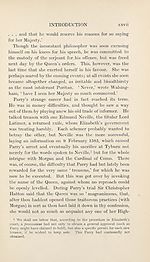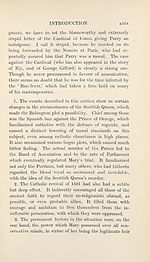Series 3 > Mary Queen of Scots and the Babington plot
(33) Page xxviii
Download files
Complete book:
Individual page:
Thumbnail gallery: Grid view | List view

xxviii MARY STUART AND THE BABINGTON PLOT
ness’s Privy Council with it. . . . No not till this enter¬
prise [with Neville] was discovered and made manifest.’
This was a cryptic way of saying that the Queen had
changed her mind, and would defend him no longer; so
Parry underwent, in Palace Yard, Westminster, the appal¬
ling sentence for high treason on the 2nd of March 1585.
Though his conspiracy was a bogus one from first to last,
it was, of course, highly criminal in itself. One cannot
affect sympathy with the victim, though he was perhaps
no worse than many another courtier of that day.
The incident of Dr. Parry is important on many accounts.
Keeping, however, the circumstances of the Babington
plot in view we may notice that Parry tried thrice, but in
vain, to elicit from priests opinions in favour of regicide.
He consulted Father William Crichton about it at Lyons,
probably early in 1583, but the Scotsman repeatedly
answered, Omnino non licet, ‘ It is altogether forbidden,’
and explained that if priests cause bloodshed they become
irregular; that is, unable to exercise their sacerdotal
functions.1
When leaving France, early in 1584, Parry met William
Watts, or Waytes,2 a secular priest, and began to talk to
him of his plans, altering, however, the names of those
concerned. Watts pronounced this case ‘ utterly unlawful,
and with him many English Priests did agree, as I have
heard.’ Christopher Driland, a priest in England, con¬
sulted by Parry, also dissuaded him. But because he
did not denounce him, he was afterwards kept in prison
till the end of Elizabeth’s long reign.3
But against this united feeling of English and Scottish
1 Holinshed, Chronicle, iv. 572. R.O., France, xiii., under 1 March
1:585, a letter from Crichton, who says, ‘ Whosoever was consenting to
the conspiration of any death, was to be degraded and deprived [? of the
use of] his order of priesthood, and to be punished with extremity.’
2 Parry’s Declaration, § 3. In State Trials, Holinshed, etc.
3 Law, Jesuits and Seculars, 1889, p. 135.
ness’s Privy Council with it. . . . No not till this enter¬
prise [with Neville] was discovered and made manifest.’
This was a cryptic way of saying that the Queen had
changed her mind, and would defend him no longer; so
Parry underwent, in Palace Yard, Westminster, the appal¬
ling sentence for high treason on the 2nd of March 1585.
Though his conspiracy was a bogus one from first to last,
it was, of course, highly criminal in itself. One cannot
affect sympathy with the victim, though he was perhaps
no worse than many another courtier of that day.
The incident of Dr. Parry is important on many accounts.
Keeping, however, the circumstances of the Babington
plot in view we may notice that Parry tried thrice, but in
vain, to elicit from priests opinions in favour of regicide.
He consulted Father William Crichton about it at Lyons,
probably early in 1583, but the Scotsman repeatedly
answered, Omnino non licet, ‘ It is altogether forbidden,’
and explained that if priests cause bloodshed they become
irregular; that is, unable to exercise their sacerdotal
functions.1
When leaving France, early in 1584, Parry met William
Watts, or Waytes,2 a secular priest, and began to talk to
him of his plans, altering, however, the names of those
concerned. Watts pronounced this case ‘ utterly unlawful,
and with him many English Priests did agree, as I have
heard.’ Christopher Driland, a priest in England, con¬
sulted by Parry, also dissuaded him. But because he
did not denounce him, he was afterwards kept in prison
till the end of Elizabeth’s long reign.3
But against this united feeling of English and Scottish
1 Holinshed, Chronicle, iv. 572. R.O., France, xiii., under 1 March
1:585, a letter from Crichton, who says, ‘ Whosoever was consenting to
the conspiration of any death, was to be degraded and deprived [? of the
use of] his order of priesthood, and to be punished with extremity.’
2 Parry’s Declaration, § 3. In State Trials, Holinshed, etc.
3 Law, Jesuits and Seculars, 1889, p. 135.
Set display mode to:
![]() Universal Viewer |
Universal Viewer | ![]() Mirador |
Large image | Transcription
Mirador |
Large image | Transcription
Images and transcriptions on this page, including medium image downloads, may be used under the Creative Commons Attribution 4.0 International Licence unless otherwise stated. ![]()
| Scottish History Society volumes > Series 3 > Mary Queen of Scots and the Babington plot > (33) Page xxviii |
|---|
| Permanent URL | https://digital.nls.uk/127234437 |
|---|
| Attribution and copyright: |
|
|---|
| Description | Over 180 volumes, published by the Scottish History Society, containing original sources on Scotland's history and people. With a wide range of subjects, the books collectively cover all periods from the 12th to 20th centuries, and reflect changing trends in Scottish history. Sources are accompanied by scholarly interpretation, references and bibliographies. Volumes are usually published annually, and more digitised volumes will be added as they become available. |
|---|


